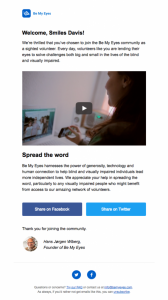Four emails your nonprofit organization should be sending
Email is an indispensable tool for nonprofit marketers. Through email marketing, you can spread the word about your cause and engage more deeply with your audiences.
In this post, you’ll get to know about four different emails that your organization needs to send to subscribers. We’ll walk you through the best practices to maximize your messages, thereby improving engagement.
1. Welcome emails
Earlier this year, Campaign Monitor published an email marketing benchmarks guide. We took billions of emails sent through our platform in 2018. We analyzed the data from these emails and compiled the results into one comprehensive resource.
This was to allow brands to see how their emails stacked up against not just their competitors, but also other industries. Our guide contains data from more than 20 industries, with one of them being nonprofit.
According to nonprofit email marketing benchmarks for 2019, the average email open rate for nonprofit organizations is 20.39%—the highest open rate among all industries represented in the benchmarks.
However, that doesn’t mean you can afford to put less effort into your email open rates. For consistently high opens, you’ll want to send welcome emails to all your new subscribers.

Source: Really Good Emails
To ensure that new subscribers (prospective donors) open your welcome emails, remember these tips:
- Personalize your welcome emails by including your subscribers’ first names in the subject line and greeting. This helps you forge a deeper connection and develop good relationships with your subscribers.
- Humanize your welcome emails by using the name of an actual person. Your subscribers will be more inclined to open your email if the from name and email address reflect the name of a real person rather than something generic like email@nonprofitorg.com.
- Automate your welcome emails so that new subscribers receive them immediately. This way, your organization is still fresh in their minds.
ENewsletters
With newsletters, you can foster meaningful engagement with your subscribers. The great thing about newsletters is that you can leverage them in a wide variety of ways.
You can use newsletters to:
- Inform subscribers of your advocacy and the reasons your organization exists
- Tell stories about your campaigns that have helped people
- Provide updates about ongoing projects
- Entice subscribers to volunteer or make donations
- Provide information to subscribers about how your organization helps people.

Source: Campaign Monitor
Improving engagement with your newsletters involves using all of the subscriber information you have at your disposal. Create strong segments so that you can send content that is relevant to each segment.
It’s also crucial that you perfect the timing and cadence of your newsletters. A/B test different times and schedules to determine when your subscribers engage with you the most. Once you figure these out, stick to the same timing and cadence for your newsletters so that your subscribers always know what to expect.
Lastly, make sure that you design your emails to render perfectly on all devices. More than 50% of email opens occur on mobile, so don’t neglect your mobile optimization efforts.
Survey emails
Survey emails are one of the most important messages in your nonprofit email arsenal. They allow you to show your prospective and current donors that you value their opinions.
Surveys are also great for gathering information about a particular subject matter that your organization cares about.

Source: Campaign Monitor
When you send survey emails, you obviously want subscribers to complete the survey. Here’s how you can make it easy for subscribers to do so.
Keep it simple.
The design of your email should be as simple as possible. Including a lot of visuals will only distract subscribers from completing your survey. Furthermore, avoid fluff when it comes to your email copy. Your survey questions should be straightforward.
Incentivize your subscribers.
To encourage subscribers to respond, you can offer them something in exchange for their time and effort. This could be free merchandise such as t-shirts, caps, or some other small item.
Send surveys only when they matter.
While incentivizing your subscribers to respond is important, you must also remember that surveys take time out of a subscriber’s day. As such, avoid sending surveys to your subscribers too often.
In addition to keeping your surveys simple, you should also use them only when needed. This way, your subscribers don’t get overwhelmed with questions, which can cause a decrease in engagement and lead to unsubscribes.
Event emails
If your nonprofit organizes events, then event email invitations are a must.
By sending event emails to your email subscribers, you can invite potential supporters to your events and increase awareness for your cause at the same time.

Source: Campaign Monitor
If you want to write event invitation emails that drive attendance, follow these best practices:
- Include all the pertinent information in your email, which can include:
-
- The name of your event
- The purpose of your event (what are you trying to achieve?)
- The benefit of attending your event
- The time and location of your event
- The link to your event website that subscribers can click to get more info.
- A prominent call to action that allows subscribers to register to your event.
Target your invitations
Rather than sending out invitations en masse, send them only to specific subscribers. Targeting your invites results in better email engagement and higher event turnout.
You can target subscribers who are in close proximity to the location of your event, are regular donors, and even those subscribers who constantly engage with your emails.
Perform A/B testing
Test different elements of your email so that you can determine which combination of elements will get the best results. You can test the subject line (length and tone), the CTA (plain link vs button), the sender’s name and email address (your nonprofit director’s name vs. email@nonprofit.com), the send time (weekday vs. weekend), and the send cadence (daily vs. weekly).
That being said, you shouldn’t limit your A/B testing to your event emails. You can apply these same exact techniques to any of the other email messages mentioned in this post.
Wrap up
There you have it. Four emails that you can take advantage of as well as what you need to do to make the most out of these emails. Whether you’re trying email for the first time or revamping your current strategies, following the advice detailed in this post will give you results.



 PRINT
PRINT
